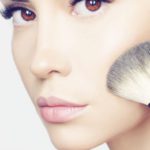
Loose or pressed powder? What’s the difference between them? And which one should I be using?
Powders help to set foundation and concealer, and can be applied with a brush, a puff or sponge, or a combination of the two. They absorb to any oils sitting on your skin, reducing shine and creating a matte effect. Powder applied with a brush will give an even application, from a light dusting to more full coverage. Using a puff is great when setting concealer on blemishes and/or problem areas, or on oily complexions that require a little more help combat shine.
But what is the difference between loose and pressed? Are they really all that different? Is one better suited to a particular skin type?
Loose powder comes in a fairly large tub and provides more coverage when applied to your skin as it can be applied with either a brush, puff, or sponge. It’s lightweight and gives a more natural looking finish as it won’t cake or settle into creases and fine lines. Apply loose powder with a brush for a light and more even application, or with a puff to set concealer or in areas requiring higher coverage or a matte appearance – lightly brush off any excess after applying with a puff or sponge.
 Pressed powder – also known as compact powder – comes in a smaller, more portable, compact packaging. Pressed powder is best kept in a handbag or travel bag and used for emergency touch-ups during the day, and it’s usually applied with a puff or sponge that comes with the compact. Pressed powder often settles into fine lines and wrinkles, accentuating them. A brush can be used with compact powder, but a sponge or puff usually fits into the packaging, making it easier to travel with.
Pressed powder – also known as compact powder – comes in a smaller, more portable, compact packaging. Pressed powder is best kept in a handbag or travel bag and used for emergency touch-ups during the day, and it’s usually applied with a puff or sponge that comes with the compact. Pressed powder often settles into fine lines and wrinkles, accentuating them. A brush can be used with compact powder, but a sponge or puff usually fits into the packaging, making it easier to travel with.










Leave a Reply
You must be logged in to post a comment.